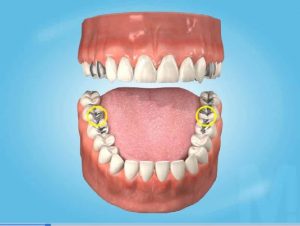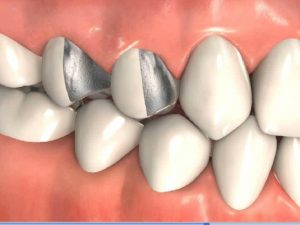Amalgam fillings are a well-established and inexpensive way to repair tooth damage. They offer a highly effective way to restore the structure and functionality of a tooth, particularly the back teeth. This type of filling has been used for over 180 years, so it has been tried and tested on millions of mouths.
Having a filling is an extremely common procedure (around 8 million cavities are treated with amalgam fillings each year in the UK) and most of us, at some point in our lives, will have a cavity that needs attention. Amalgam fillings are the traditional choice, made from a combination of metals including tin, copper, silver and mercury. Although the inclusion of mercury has attracted some controversy, a number of scientific studies have concluded that it has no adverse side effects.
However, an alternative type of filling would be used for those patients who have an allergy to any of the metals within the amalgam and would also be recommended for women who require treatment while pregnant.
Benefits
- Extremely hard wearing
- Quicker to place than composite fillings
- Less expensive than alternative restorative methods
Treatment steps
- The area to be treated is numbed with a local anaesthetic and the decayed part of the tooth removed with special dental tools.
- A base or liner may be placed in the tooth to prevent sensitivity following the procedure.
- The amalgam is mixed and then placed in the tooth. It is tightly compacted to ensure every part of the cavity is filled.
- The amalgam is then shaped to resemble the tooth and, if necessary, it is smoothed down so it feels comfortable.
Aftercare
If looked after properly, amalgam fillings can last for years and are particularly suitable for teeth that are subjected to lots of wear and tear, such as those at the back of the mouth. More discreet composite (white) fillings can be used to treat decayed teeth but these are more expensive and less durable.
Why should I consider white fillings?
Most people have fillings of one sort or another in their mouths. Nowadays fillings are not only functional, but can be natural looking as well. Many people don’t want silver fillings that show when they laugh or smile because they are more conscious about the way they look.
Can I get them on the NHS?
The National Health Service will not usually allow white fillings on the biting surfaces of back teeth. However, this does not apply to the sides of back teeth or to any front teeth.
There is a slight chance that some people may be sensitive to the metals used in silver amalgam fillings. If this sensitivity is proven, it may be best to replace the amalgam fillings with another type. (In very exceptional cases these replacements may be available on the NHS, if a consultant decides that a patient is extremely sensitive to these materials and asks for them to be replaced.)
Are they expensive?
Because many white fillings are only available privately, costs can vary quite a lot from dentist to dentist. Costs usually depend on the size and type of white filling used and the time it takes to complete the treatment. Costs may also vary from region to region .
Are they as good as silver amalgam fillings?
White fillings have always been considered less long lasting than silver amalgam fillings. But there are now new materials available with properties comparable to silver amalgam, and these are proving to be very successful.
be very successful.
The life expectancy of a white filling can depend greatly on where it is in your mouth and how heavily your teeth come together when you bite. Your dentist can advise you on the life expectancy of your fillings. However, any
fillings provided on the NHS are automatically guaranteed for one year.
Is it worth replacing my amalgam fillings with white ones?
It is usually best to change fillings only when your dentist decides that an old filling needs replacing. If so you can ask to have it replaced in a tooth-coloured material.
Some dentists prefer not to put white fillings in back teeth, as they are not always successful. One way around this would be to use crowns or inlays, but this can mean removing more of the tooth and can be more expensive.
What are tooth-coloured fillings made of?
 This can vary, but they are mainly made of glass particles, synthetic resin and a setting ingredient. Your dentist should be able to give you more information about the particular material that they use.
This can vary, but they are mainly made of glass particles, synthetic resin and a setting ingredient. Your dentist should be able to give you more information about the particular material that they use.
Where can I get them done?
Most dental practices offer white fillings as a normal part of the treatment they give you. However, white fillings are classed as a ‘cosmetic’ treatment, and you can therefore only have them if you pay for them.
Are there any alternatives to fillings?
Adhesive dentistry is another form of this treatment. This involves bonding the filling to the tooth. The dentist has to remove less of the tooth, which is obviously better.
As we have already said, there are alternatives such as crowns and inlays although they can cost a lot more. Veneers can be used on front teeth instead of crowns or fillings.
